十大排序算法的数组和链表实现
Contents
发现一个牛逼的数据结构与算法的可视化网站(https://visualgo.net/zh)
链表定义:
Definition for singly-linked list.
struct ListNode {
int val;
ListNode *next;
ListNode(int x) : val(x), next(NULL) {}
};
概述
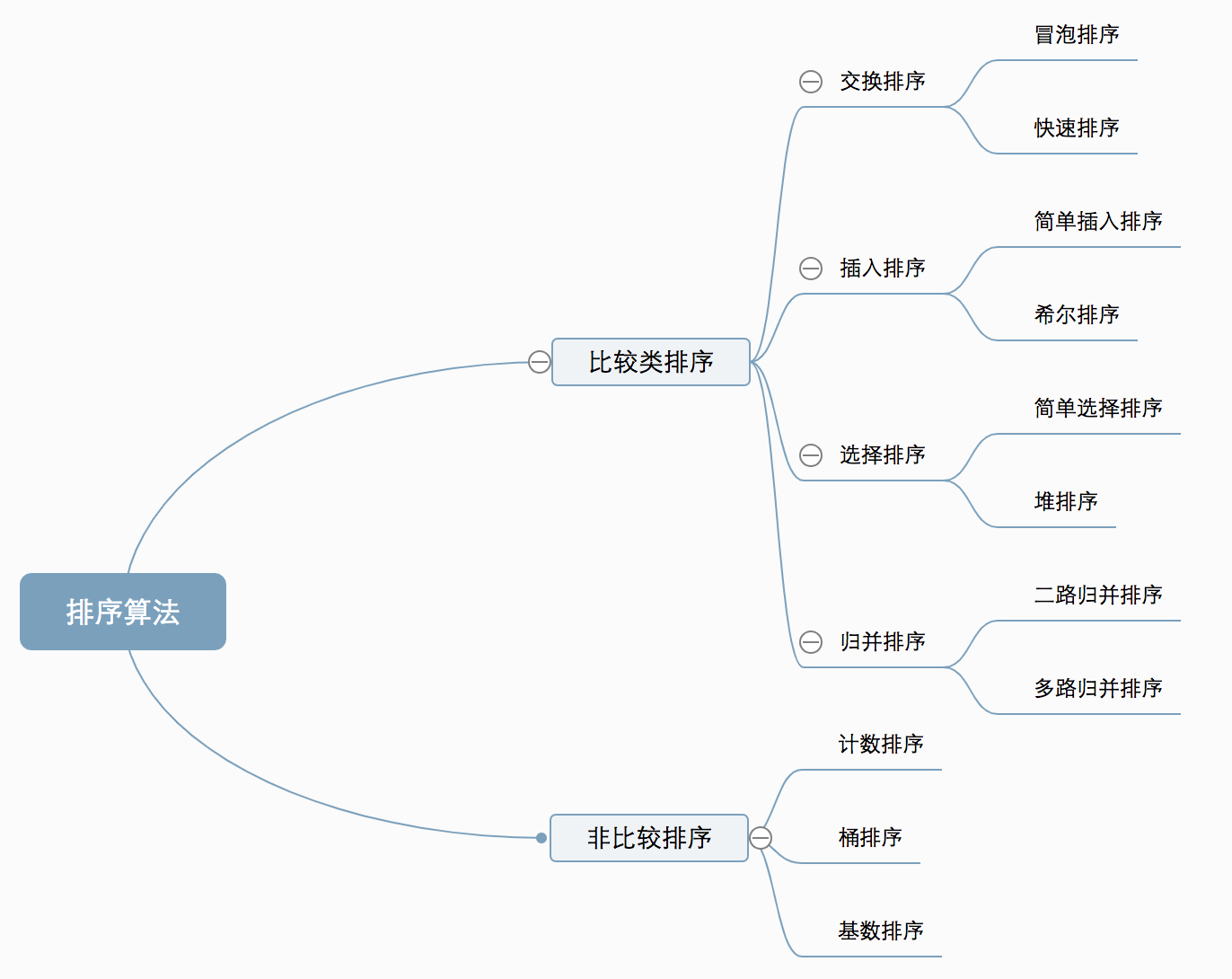
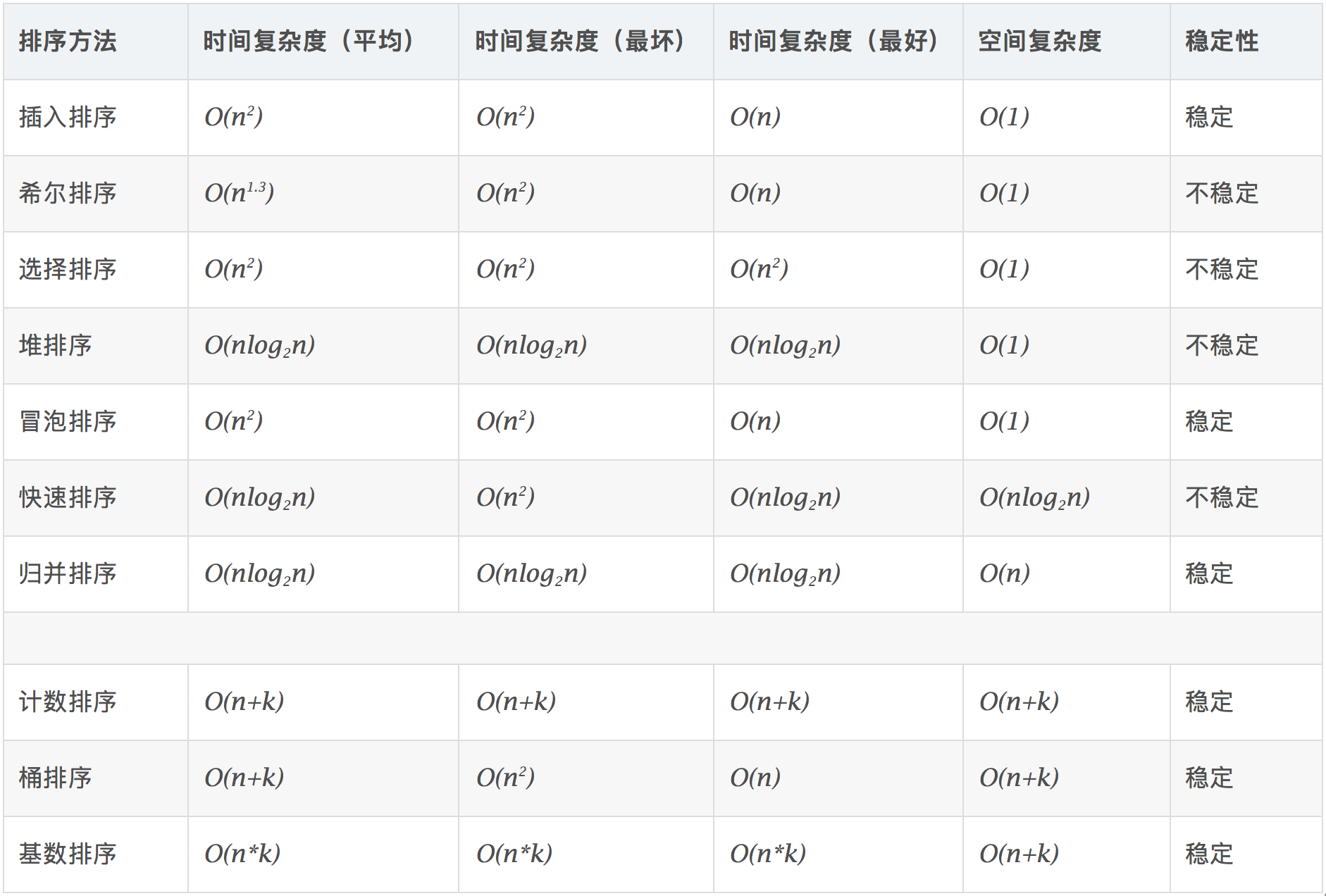
相关概念
- 稳定:如果a原本在b前面,而a=b,排序之后a仍然在b的前面。
- 不稳定:如果a原本在b的前面,而a=b,排序之后 a 可能会出现在 b 的后面。
- 时间复杂度:对排序数据的总的操作次数。反映当n变化时,操作次数呈现什么规律。
- 空间复杂度:是指算法在计算机内执行时所需存储空间的度量,它也是数据规模n的函数。
1. 冒泡排序(Bubble Sort)

- 平均时间复杂度$O(N^{2})$
- 空间复杂度$O(1)$
- 稳定
数组
#include <bits/stdc++.h>
using namespace std;
//注意:本算法排序要求链表在2个及以上,暂未加入对于0 1个数的排序;数组不能为空
//newoder pass
array
int main(){
ios::sync_with_stdio(0);
cin.tie(0);
int tmp = 0;
vector<int> a;
cin>>tmp;
a.push_back(tmp);//注意用cin.get()要先输入一个数字,然后用cin.get()去接受空格和回车
while(true){
if(cin.get()=='\n') break;
cin>>tmp;
a.push_back(tmp);
}
bool isChange = true;//标志位用来标记这一轮是否进行过交换,未交换说明数组已经有序
int n = a.size();
for(int i=0; i<n-1; i++){
if(!isChange) break;
isChange = false;
for(int j=0; j<n-i-1;j++){
if(a[j] > a[j+1]){
// int tmp = a[j+1];
// a[j+1] = a[j];
// a[j] = tmp;
swap(a[j],a[j+1]);
isChange = true;
}
}
}
for(const int &e:a){
cout<<e<<' ';
}
cout<<'\n';
}
链表
交换val的值
class Solution {
public:
ListNode* insertionSortList(ListNode* head) {
if(!head || !head->next) return head;
ListNode *dummy = new ListNode(0);
dummy->next = head;
auto cur = dummy->next;
bool isChange = true;//标志位用来标记这一轮是否进行过交换,未交换说明数组已经有序
ListNode *tail = nullptr;//冒泡的范围是[head,tail),head就是cur
while(tail != cur->next && isChange){//若尾部指针tail没到第二位,继续冒泡
ListNode *p = cur;//p从cur开始
isChange = false;
for(;p->next != tail; p = p->next){//从前往后,直到tail
if(p->val > p->next->val){
swap(p->val, p->next->val);
isChange = true;
}
}
}
return dummy->next;
}
};
2. 选择排序(Selection Sort)

- 平均时间复杂度$O(N^{2})$
- 空间复杂度$O(1)$
- 不稳定
数组
#include <bits/stdc++.h>
using namespace std;
////注意:数组不能为空
//array
int main(){
ios::sync_with_stdio(0);
cin.tie(0);
int tmp = 0;
vector<int> a;
int n = 0;
cin>>n;
cin>>tmp;
a.push_back(tmp);//注意用cin.get()要先输入一个数字,然后用cin.get()去接受空格和回车
while(true){
if(cin.get()=='\n') break;
cin>>tmp;
a.push_back(tmp);
}
for(int i=0; i<a.size()-1; i++){
int min_index = i;
for(int j=i+1; j<a.size(); j++){
if(a[j] < a[min_index]) min_index = j;
}
if(min_index != i) swap(a[i],a[min_index]);
}
for(const int &e:a){
cout<<e<<' ';
}
cout<<'\n';
}
链表
交换val的值
占坑
3. 插入排序(Insertion Sort)
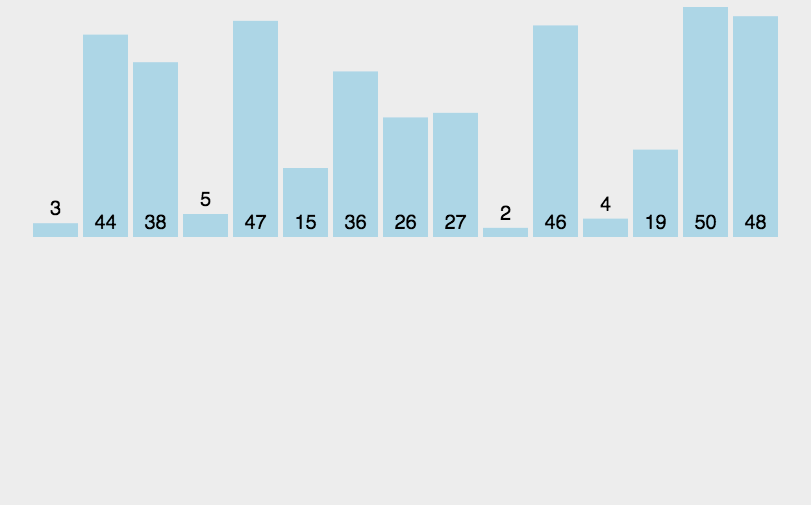
- 平均时间复杂度$O(N^{2})$
- 空间复杂度$O(1)$
- 稳定
数组
#include <bits/stdc++.h>
using namespace std;
////注意:数组不能为空
////nowcoder pass
//array
int main(){
ios::sync_with_stdio(0);
cin.tie(0);
int tmp = 0;
vector<int> a;
cin>>tmp;
a.push_back(tmp);//注意用cin.get()要先输入一个数字,然后用cin.get()去接受空格和回车
while(true){
if(cin.get()=='\n') break;
cin>>tmp;
a.push_back(tmp);
}
for(int i=1; i<a.size(); ++i){//有序区的长度依次递增,范围为[0,i)
for(int j=i; j>0; --j){//从i开始往前挨个比较
if(a[j] < a[j-1]) swap(a[j],a[j-1]);//若小就
else break;
}
}
for(const int &e:a){
cout<<e<<' ';
}
cout<<'\n';
}
链表
交换节点
占坑
4. 希尔排序(Shell Sort)
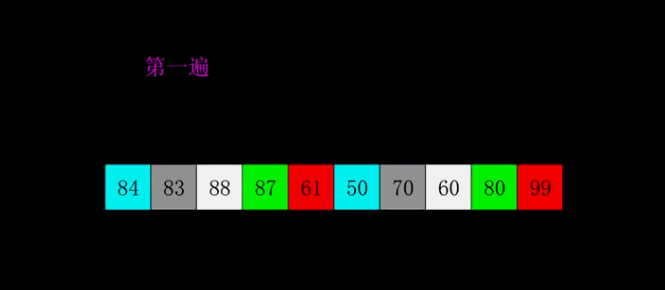
- 平均时间复杂度$O(N^{1.3})$
- 空间复杂度$O(1)$
- 不稳定
数组
#include <bits/stdc++.h>
using namespace std;
////注意:数组不能为空
///nowcoder pass
//array
int main(){
ios::sync_with_stdio(0);
cin.tie(0);
int tmp = 0;
vector<int> a;
int n = 0;
cin>>n;//这个是nowcoder会用到的一个n,用来记录数组长度
cin>>tmp;
a.push_back(tmp);//注意用cin.get()要先输入一个数字,然后用cin.get()去接受空格和回车
while(true){
if(cin.get()=='\n') break;
cin>>tmp;
a.push_back(tmp);
}
n = a.size();
int dis = n/2;//设置步长,保证小于n,且最后能迭代到1就行,如dis/3-1
while(dis>=1){//缩短到dis=1停止
for(int i=dis; i<n; i++){//通过dis选择比较的第二个数的位置
for(int j=i-dis; j>=0; j -= dis){//注意j-dis若>=0,继续比较
if(a[j] > a[j+dis]) swap(a[j], a[j+dis]);
}
}
dis /= 2;//全部交换完成,dis减小,此处应该和dis定义处相同,即可以为dis/3-1
}
for(const int &e:a){
cout<<e<<' ';
}
cout<<'\n';
}
链表
对于希尔排序,因为排序过程中经常涉及到a[i+dis]操作,其中dis为希尔排序的当前步长,这种操作不适合链表。
5. 堆排序(Heap Sort)
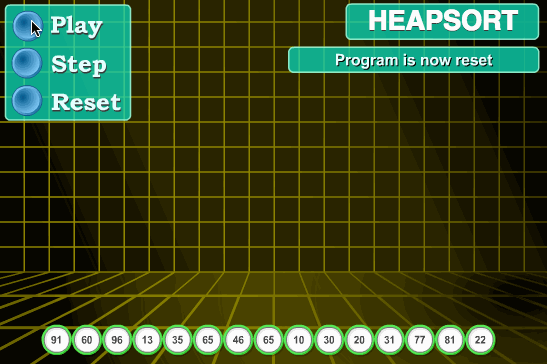
- 平均时间复杂度$O(Nlog{N})$
- 空间复杂度$O(1)$
- 不稳定
数组
#include <bits/stdc++.h>
using namespace std;
////注意:数组不能为空
///nowcoder pass
//array
void heapify(vector<int>& a, int father, int end){
int son = father*2+1;
while(son<end){
if(son+1 < end && a[son] < a[son+1]) son++;//取两个子节点里面大的
if(a[father] > a[son]) break;//若father>son,说明三个数里面最大的数已经在顶上
else{
swap(a[father],a[son]);
father = son;//变化的son变为father继续取最大
son = son*2+1;
}
}
}
int main(){
ios::sync_with_stdio(0);
cin.tie(0);
int tmp = 0;
vector<int> a;
int n = 0;
cin>>n;//这个是nowcoder会用到的一个n,用来记录数组长度
cin>>tmp;
a.push_back(tmp);//注意用cin.get()要先输入一个数字,然后用cin.get()去接受空格和回车
while(true){
if(cin.get()=='\n') break;
cin>>tmp;
a.push_back(tmp);
}
n = a.size();
for(int i=n/2+1; i>=0; i--){//最后一个父节点是从n/2+1开始,从这个节点往前迭代建立第一个堆
heapify(a, i, n);
}
for(int i=n-1; i>0; --i){
swap(a[0], a[i]);//取堆顶的最大值,放到数组最后
heapify(a, 0, i);//这次只调整最大的堆顶就可以,因为其他父节点已经有序
}
for(const int &e:a){
cout<<e<<' ';
}
cout<<'\n';
}
链表
堆排序也经常会有跨越多个节点找子节点的情况,因此不适合链表。
也可以用二叉树实现,但需要额外空间,比较复杂。
6. 归并排序(Merge Sort)

- 平均时间复杂度$O(Nlog{N})$
- 空间复杂度$O(N)$(非递归法); $O(N+log{N})$(递归法)
- 稳定
数组
递归
#include <bits/stdc++.h>
using namespace std;
////注意:数组不能为空
///nowcoder pass
//array
//递归
void Merge(vector<int>& a, vector<int> &b, int start1, int end1, int start2, int end2){
int b_start = start1;//定义b开始位置的指针
int tmp_start = start1;
while(start1 <= end1 && start2 <= end2){
b[b_start++] = a[start1] < a[start2]? a[start1++]:a[start2++];//取两序列比较中小的值
}
while(start1 <= end1) b[b_start++] = (a[start1++]);
while(start2 <= end2) b[b_start++] = (a[start2++]);//会有一个序列还剩一些数,接到b后面
//在b中排好序再放入a中
for(int i=tmp_start; i<=end2; i++){
a[i] = b[i];
}
}
void MergeSort(vector<int>& a, vector<int>& b, int start, int end){
if(start >= end) return;//递归终止条件
int mid = (end-start)/2 + start;//计算中间值
int start1 = start, end1 = mid;
int start2 = mid+1, end2 = end;//把数组分成两部分
MergeSort(a, b, start1, end1);
MergeSort(a, b, start2, end2);//两部分分别归并
Merge(a, b, start1, end1, start2, end2);
}
int main(){
ios::sync_with_stdio(0);
cin.tie(0);
int tmp = 0;
vector<int> a;
int n = 0;
cin>>n;//这个是nowcoder会用到的一个n,用来记录数组长度
cin>>tmp;
a.push_back(tmp);//注意用cin.get()要先输入一个数字,然后用cin.get()去接受空格和回车
while(true){
if(cin.get()=='\n') break;
cin>>tmp;
a.push_back(tmp);
}
n = a.size();//a是原始数组
vector<int> b(n);//b是用来辅助排序的数组
MergeSort(a,b,0,n-1);
for(const int &e:a){
cout<<e<<' ';
}
cout<<'\n';
}
非递归
#include <bits/stdc++.h>
using namespace std;
////注意:数组不能为空
///nowcoder pass
//array
//非递归
void Merge(vector<int>& a, vector<int> &b, int start1, int end1, int start2, int end2){
int b_start = start1;
int tmp_start = start1;
while(start1 <= end1 && start2 <= end2){
b[b_start++] = a[start1] < a[start2]? a[start1++]:a[start2++];//取两序列比较中小的值
}
while(start1 <= end1) b[b_start++] = (a[start1++]);
while(start2 <= end2) b[b_start++] = (a[start2++]);//会有一个序列还剩一些数,接到b后面
for(int i=tmp_start; i<=end2; i++){
a[i] = b[i];
}
}
//主要区别在于这一部分不使用递归实现了
void MergeSort(vector<int>& a, vector<int>& b, int start, int end){
int n = end-start+1;//n是数组的长度
//从下向上,先1个1个,再2个2个,最后到stride为n,进行归并
for(int stride = 1;stride <= n; stride *= 2){
int i = start;
//按stride为步长进行两两归并,当数组剩下的数少于2*stride时停止
for(; i<=end-2*stride+1; i += 2*stride){
Merge(a, b, i, i+stride-1, i+stride, i+2*stride-1);
}
//看剩下的数够不够1个stride,够的话就再归并一次,即使两个数组长度可能不一样
if(i < end-stride+1){
Merge(a, b, i, i+stride-1, i+stride, end);
}
}
}
int main(){
ios::sync_with_stdio(0);
cin.tie(0);
int tmp = 0;
vector<int> a;
int n = 0;
cin>>n;//这个是nowcoder会用到的一个n,用来记录数组长度
cin>>tmp;
a.push_back(tmp);//注意用cin.get()要先输入一个数字,然后用cin.get()去接受空格和回车
while(true){
if(cin.get()=='\n') break;
cin>>tmp;
a.push_back(tmp);
}
n = a.size();
vector<int> b(n);
MergeSort(a,b,0,n-1);
for(const int &e:a){
cout<<e<<' ';
}
cout<<'\n';
}
链表
递归
class Solution {//用归并排序,且不能用递归(因为递归会用到栈,会用到O(n)级别的空间复杂度)
//但是写个递归练练手,正确答案看第一个提交结果,merge直接用双路归并merge。递归方法不用cut,各种边界条件还得记记
public:
ListNode* sortList(ListNode* head) {//递归方法不用哑节点,另一种方法需要
if(!head || !head->next) return head;//当只有0-1个数时,直接返回该链表,不用排序
auto *slow = head, *fast = head, *pre = head;
//三个指针,slow,fast用于找终点,pre指向中点前一个节点,slow指向中点后一个节点
//注意这里中点是靠前的一个,奇数个节点fast指向最后一个数,偶数个节点fast指向nullptr
while(fast && fast->next){//注意这种前进两个指针fast的需要判断两个值
pre = slow;
slow = slow->next;
fast = fast->next->next;
}
pre->next = nullptr;//断开链表
return merge(sortList(head),sortList(slow));//调用递归双路归并
}
ListNode* merge(ListNode* l1, ListNode* l2){//双路归并
auto DummyHead = new ListNode(-1);//哑节点
auto cur = DummyHead;//注意这里哑节点先不加入链表,用于创建新链表
while(l1 && l2){
if(l1->val < l2->val){
cur->next = l1;
l1 = l1->next;
}
else{
cur->next = l2;
l2 = l2->next;
}//哪个小接哪个
cur = cur->next;//cur指针后移一位
}
cur->next = l1? l1:l2;//一条链遍历完成另一条可能还有剩余,因此判断哪条有剩并接上
return DummyHead->next;
}
};
非递归
leetcode#148里提到使用栈会使用额外的空间,空间复杂度不为常数,因此应该使用迭代
/*迭代写法*/
class Solution {//用归并排序,且不能用递归(因为递归会用到栈,会用到O(n)级别的空间复杂度)
//两个重要函数
//双路归并(merge):挨个比较两链表的节点大小,哪个小(大)取哪个接在新链表后面
//断链(cut):将链表 l 切掉前 n 个节点,并返回后半部分的链表头。
public:
ListNode* sortList(ListNode* head) {
auto DummyHead = new ListNode(-1);//哑节点
DummyHead->next = head;//这里哑节点要接上
auto p = head;//p用于计数
int length = 0;
while(p){
length++;
p = p->next;
}//这一段用来算链表长度length
for(int size=1; size < length; size <<= 1){
//第一次切成每份一个数,第二次两个数。。。用size左移一位表示size*2
auto cur = DummyHead->next;//cur表示该切的链表头部
auto tail = DummyHead;//tail表示切完的前一个链表的尾部,用于接上下一个合并的链表
while(cur){
auto left = cur;//设定需要切的链表第一条链表头
auto right = cut(left,size);//设定需要切的第二条链表表头
cur = cut(right,size);//将cur移动到第二条链表后面
tail->next = merge(left,right);
while(tail->next){//注意是判断next是否存在,否则tail会指向nullptr
tail = tail->next;
}
}
}
return DummyHead->next;//返回哑节点后面的值
}
ListNode* cut(ListNode* head, int n){//n是到第几位切断,注意只切断前半段,后半段不用切断
auto first = head;//设置标记断点前半的指针
while(--n && first) first = first->next;//将first指针移动到断点前
if(!first) return nullptr;//若前半段已经遍历完该链表,则返回空指针
auto second = first->next;
first->next = nullptr;//断开两条链
return second;//返回后半段的链表头
}
ListNode* merge(ListNode* l1, ListNode* l2){//双路归并
auto DummyHead = new ListNode(-1);//哑节点
auto cur = DummyHead;//注意这里哑节点先不加入链表,用于创建新链表
while(l1 && l2){
if(l1->val < l2->val){
cur->next = l1;
l1 = l1->next;
}
else{
cur->next = l2;
l2 = l2->next;
}//哪个小接哪个
cur = cur->next;//cur指针后移一位
}
cur->next = l1? l1:l2;//一条链遍历完成另一条可能还有剩余,因此判断哪条有剩并接上
return DummyHead->next;
}
};
7. 快速排序(Quick Sort)

- 平均时间复杂度$O(Nlog{N})$
- 空间复杂度$O(Nlog{N})$
- 不稳定
数组
递归
#include <bits/stdc++.h>
using namespace std;
////注意:数组不能为空
///nowcoder pass
//array
int Partition(vector<int>& a, int low, int high){
int key_value = a[low];
while(low<high){
while(low < high && a[high] >= key_value) high--;
a[low] = a[high];
while(low < high && a[low] <= key_value) low++;
a[high] = a[low];
}
a[low] = key_value;
return low;
}
void QuickSort(vector<int>& a, int start, int end){
int mid;
if(start<end){
mid = Partition(a, start, end);
QuickSort(a, start, mid-1);
QuickSort(a, mid+1, end);
}
}
int main(){
ios::sync_with_stdio(0);
cin.tie(0);
int tmp = 0;
vector<int> a;
int n = 0;
cin>>n;//这个是nowcoder会用到的一个n,用来记录数组长度
cin>>tmp;
a.push_back(tmp);//注意用cin.get()要先输入一个数字,然后用cin.get()去接受空格和回车
while(true){
if(cin.get()=='\n') break;
cin>>tmp;
a.push_back(tmp);
}
n = a.size();
QuickSort(a, 0, n-1);
for(const int &e:a){
cout<<e<<' ';
}
cout<<'\n';
}
链表
交换val值
交换节点
占坑
以下三种排序都是用空间换时间
8. 计数排序(Counting Sort)
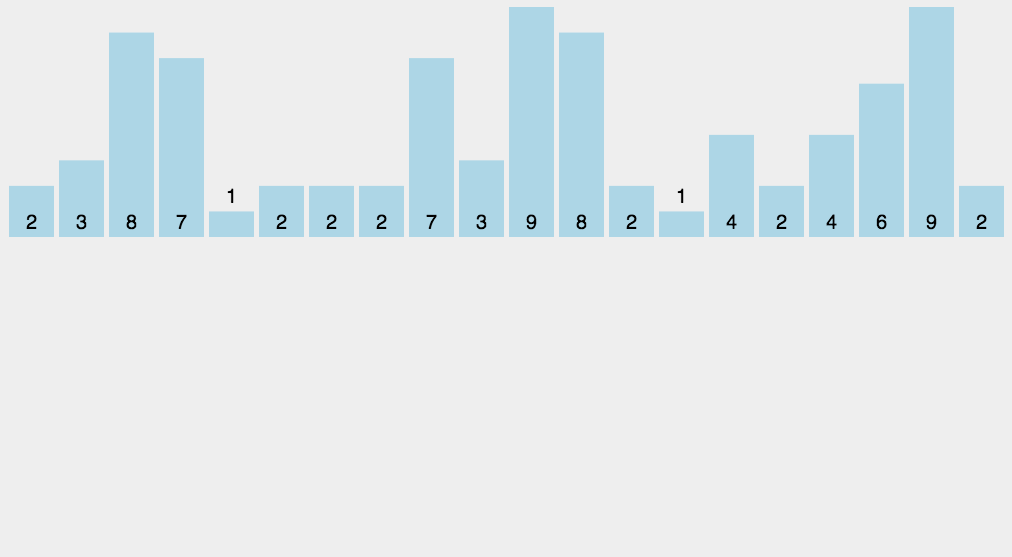
- 平均时间复杂度$O(N+K)$,K是数组最大最小值的差
- 空间复杂度$O(N+K)$
- 稳定
前面想能不能用map来计数以减少内存开销,但是若用unordered_map无法保证计数的下标递增;使用map自动排序涉及其他的时间复杂度。桶排序类似。
#include <bits/stdc++.h>
using namespace std;
////注意:数组不能为空
///nowcoder no pass,内存超了
//array
int main(){
ios::sync_with_stdio(0);
cin.tie(0);
int tmp = 0;
vector<int> a;
int n = 0;
cin>>n;//这个是nowcoder会用到的一个n,用来记录数组长度
cin>>tmp;
a.push_back(tmp);//注意用cin.get()要先输入一个数字,然后用cin.get()去接受空格和回车
while(true){
if(cin.get()=='\n') break;
cin>>tmp;
a.push_back(tmp);
}
n = a.size();
int max_value = INT_MIN;
int min_value = INT_MAX;
for(auto &v:a){
max_value = max(v, max_value);
min_value = min(v, min_value);
}//遍历数组找最大值
int b[max_value-min_value+1];
for(auto &v:a){
b[v-min_value]++;
}
a.clear();//清除原数组
for(int i=min_value; i<max_value; i++){
while(b[i]--){
a.push_back(i);
}//计数完成的数字挨个放入原数组
}
for(const int &e:a){
cout<<e<<' ';
}
cout<<'\n';
}
9. 桶排序(Bucket Sort)
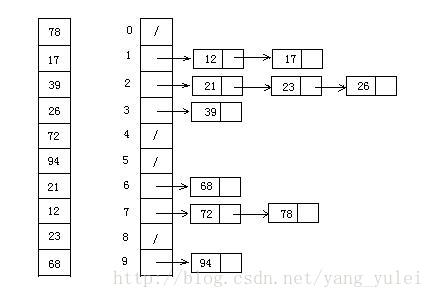
- 平均时间复杂度$O(N+K)$,K是数组最大最小值的差
- 空间复杂度$O(N+K)$
- 稳定
计数排序可以算作特殊的桶排序,即一个数一个桶
时间复杂度还得考虑每个桶的插入排序,以上的时间复杂度统计似乎未考虑
数组
#include <bits/stdc++.h>
using namespace std;
////注意:数组不能为空
///nowcoder pass
//array
//计数排序是特殊的桶排序,即每个桶只存相同的数字
int main(){
ios::sync_with_stdio(0);
cin.tie(0);
int tmp = 0;
vector<int> a;
int n = 0;
cin>>n;//这个是nowcoder会用到的一个n,用来记录数组长度
cin>>tmp;
a.push_back(tmp);//注意用cin.get()要先输入一个数字,然后用cin.get()去接受空格和回车
while(true){
if(cin.get()=='\n') break;
cin>>tmp;
a.push_back(tmp);
}
n = a.size();
int max_value = INT_MIN;
int min_value = INT_MAX;
for(auto &v:a){
max_value = max(v, max_value);
min_value = min(v, min_value);
}//遍历数组找最大值
int bucket_num = 5;//设计桶的的数量,可更改
float bucket_range = ((float)max_value-(float)min_value+1)/5;//每个桶包含的范围,也可以用其他映射方式,注意是float
vector<vector<int>> buckets(bucket_num);//定义二维数组保存每个桶及桶里的元素
int bucket_key = 0;//定义记录这个数所在桶的变量
for(auto &v:a){
bucket_key = floor(((float)v-(float)min_value)/bucket_range);//每个数计算其所在桶
//下面是在每个桶内执行插入排序
if(buckets[bucket_key].empty() || v >= buckets[bucket_key].back()) buckets[bucket_key].push_back(v);
else{
for(int i=0; i<buckets[bucket_key].size(); ++i) {
if (v < buckets[bucket_key][i]) {
buckets[bucket_key].insert(buckets[bucket_key].begin()+i, v);
break;
}
}
}
}
a.clear();//原数组清空
for(int i=0; i<bucket_num; i++){
int thisBucketNum = buckets[i].size();
for(int j=0; j<thisBucketNum; j++){
a.push_back(buckets[i][j]);
}
}//从桶中挨个取出数组
for(const int &e:a){
cout<<e<<' ';
}
cout<<'\n';
}
链表
桶排序更适合用链表实现,定义一个vector保存表头,然后后续用链表保存,这个即可以用于链表排序也可以用于数组排序,前者是直接断链存到哦vector,后者是取数创建新的链表存入vector
占坑
10. 基数排序(Radix Sort)
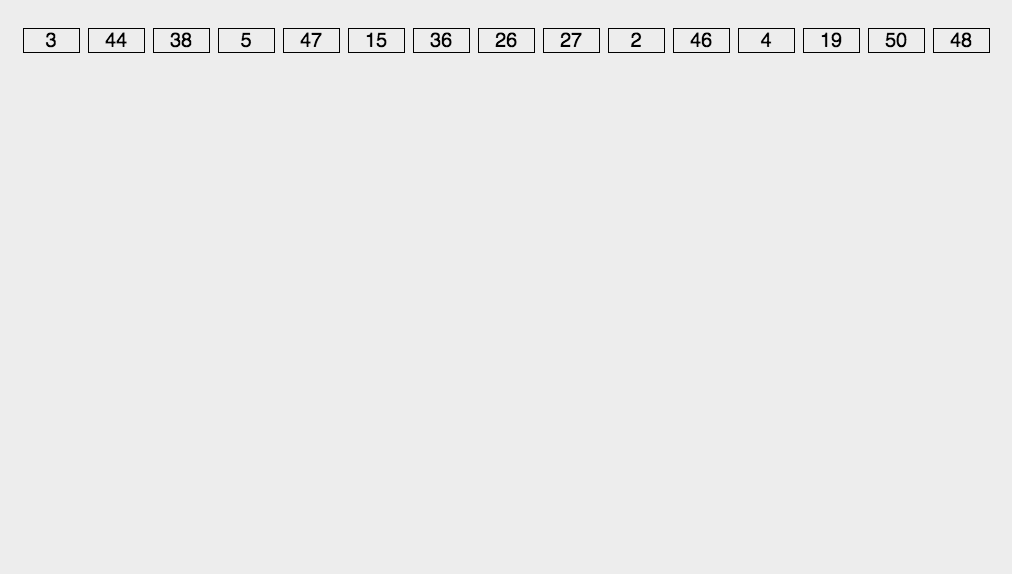
- 平均时间复杂度$O(N*d)$,d为基数的个数
- 空间复杂度$O(N+d)$
- 稳定 数组
#include <bits/stdc++.h>
using namespace std;
////注意:数组不能为空
///nowcoder no pass,内存超了
//array
void countSort(vector<int>& a, int digit){
vector<vector<int>> b(10);//定义二维数组保存数,第一维是10位
for(auto &v:a){//遍历a中的每个数
int this_digit = v%(digit*10)/digit;//求这个数在当前位的值
if(b[this_digit].empty() || v >= b[this_digit].back())
b[this_digit].push_back(v);//若这一位的数组是空的,或者比最后一个数大,直接插在最后一位
else{
for(int i=0; i<b[this_digit].size(); i++){
if(v < b[this_digit][i]){
b[this_digit].insert(b[this_digit].begin()+i, v);
break;
}
}
}//否则进行插入排序
}
a.clear();//清空原数组
for(int i=0; i<b.size(); i++){
for(int j=0; j<b[i].size(); j++){
a.push_back(b[i][j]);
}
}//挨个取数存入原数组
b.clear();
}
int main(){
ios::sync_with_stdio(0);
cin.tie(0);
int tmp = 0;
vector<int> a;
int n = 0;
cin>>n;//这个是nowcoder会用到的一个n,用来记录数组长度
cin>>tmp;
a.push_back(tmp);//注意用cin.get()要先输入一个数字,然后用cin.get()去接受空格和回车
while(true){
if(cin.get()=='\n') break;
cin>>tmp;
a.push_back(tmp);
}
n = a.size();
int max_value = INT_MIN;
for(auto &v:a){
max_value = max(v, max_value);
}//遍历数组找最大值
int mag = 1;//定义最大数的数量级
while(max_value/mag > 10) mag *= 10;
for(int i=1; i<=mag; i *= 10){
countSort(a, i);//调用按位的计数排序
}
for(const int &e:a){
cout<<e<<' ';
}
cout<<'\n';
}
参考
参考自
- https://www.cnblogs.com/tenosdoit/p/3666585.html
- https://www.cnblogs.com/onepixel/articles/7674659.html
- https://blog.csdn.net/Koala_Tree/article/details/79958965
- https://zhuanlan.zhihu.com/p/57088609 第四个我还没具体看,网址先放在这里
- https://www.runoob.com/w3cnote/ten-sorting-algorithm.html
- https://www.runoob.com/w3cnote/sort-algorithm-summary.html
Author ChrisHRZ
LastMod 2020-04-22